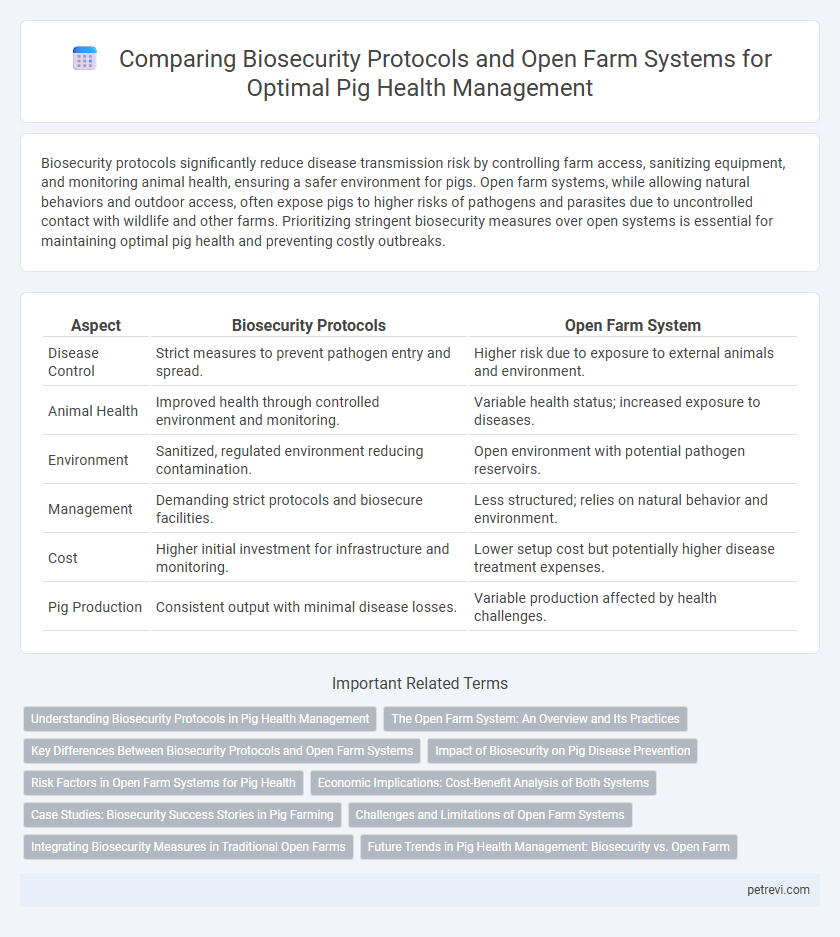Biosecurity protocols significantly reduce disease transmission risk by controlling farm access, sanitizing equipment, and monitoring animal health, ensuring a safer environment for pigs. Open farm systems, while allowing natural behaviors and outdoor access, often expose pigs to higher risks of pathogens and parasites due to uncontrolled contact with wildlife and other farms. Prioritizing stringent biosecurity measures over open systems is essential for maintaining optimal pig health and preventing costly outbreaks.
Table of Comparison
| Aspect | Biosecurity Protocols | Open Farm System |
|---|---|---|
| Disease Control | Strict measures to prevent pathogen entry and spread. | Higher risk due to exposure to external animals and environment. |
| Animal Health | Improved health through controlled environment and monitoring. | Variable health status; increased exposure to diseases. |
| Environment | Sanitized, regulated environment reducing contamination. | Open environment with potential pathogen reservoirs. |
| Management | Demanding strict protocols and biosecure facilities. | Less structured; relies on natural behavior and environment. |
| Cost | Higher initial investment for infrastructure and monitoring. | Lower setup cost but potentially higher disease treatment expenses. |
| Pig Production | Consistent output with minimal disease losses. | Variable production affected by health challenges. |
Understanding Biosecurity Protocols in Pig Health Management
Biosecurity protocols in pig health management focus on preventing the introduction and spread of infectious diseases through controlled access, sanitation measures, and monitoring of animal health. These protocols include strict regulations on farm entry, disinfection procedures, quarantine of new or sick animals, and regular health screenings to reduce pathogen transmission risks. In contrast, open farm systems expose pigs to external environmental factors and other animals, increasing vulnerability to diseases and complicating effective disease control.
The Open Farm System: An Overview and Its Practices
The Open Farm System in pig health management emphasizes natural behaviors and outdoor access, allowing pigs to forage and roam freely. This system requires meticulous monitoring of environmental conditions and strict control of potential disease exposure through rotational grazing and regular soil testing. While promoting animal welfare, it poses challenges in controlling biosecurity risks such as contact with wild animals and pathogens, necessitating comprehensive health surveillance protocols.
Key Differences Between Biosecurity Protocols and Open Farm Systems
Biosecurity protocols in pig health management emphasize controlled environments, strict sanitation, and restricted access to prevent disease introduction and spread, contrasting with open farm systems that allow pigs to roam freely and interact with external environments. These protocols utilize barriers, disinfection procedures, and health monitoring to maintain herd health, whereas open farm systems prioritize natural behaviors but face higher risks of pathogen exposure and transmission. The key differences lie in disease control rigor, environmental exposure, and management practices directly impacting pig health outcomes.
Impact of Biosecurity on Pig Disease Prevention
Implementing stringent biosecurity protocols significantly reduces the risk of infectious diseases by controlling pathogen entry and spread within pig populations. Open farm systems, with their increased exposure to external environments and vectors, often face higher disease incidence and outbreaks. Enhanced biosecurity measures directly correlate with improved pig health, lower mortality rates, and optimized production efficiency.
Risk Factors in Open Farm Systems for Pig Health
Open farm systems for pig health management face significant risks including exposure to wild animals, which can introduce diseases such as African swine fever and porcine reproductive and respiratory syndrome (PRRS). Lack of controlled environments increases vulnerability to environmental pathogens, parasites, and bio-contaminants. Limited quarantine measures and unrestricted animal movement further elevate the risk of infection and disease spread compared to strict biosecurity protocols.
Economic Implications: Cost-Benefit Analysis of Both Systems
Biosecurity protocols in pig health management involve controlled environments and strict sanitation measures, leading to higher initial costs but significantly reducing disease outbreaks and long-term treatment expenses. Open farm systems offer lower upfront investment but face increased risks of infectious diseases, resulting in unpredictable economic losses and higher veterinary costs. Cost-benefit analysis shows that while biosecurity protocols demand substantial capital, they enhance productivity and profitability by minimizing health risks and associated financial burdens.
Case Studies: Biosecurity Success Stories in Pig Farming
Case studies in pig farming demonstrate that strict biosecurity protocols significantly reduce disease outbreaks compared to open farm systems, minimizing pathogen transmission and improving overall herd health. Farms implementing controlled access, sanitation barriers, and quarantine measures consistently report lower incidences of porcine reproductive and respiratory syndrome (PRRS) and African swine fever (ASF). These success stories highlight the critical role of biosecurity in enabling sustainable pig production and enhancing productivity metrics.
Challenges and Limitations of Open Farm Systems
Open farm systems pose significant challenges for pig health management due to increased exposure to pathogens, wildlife, and environmental contaminants resulting in higher disease transmission risks such as African swine fever and porcine reproductive and respiratory syndrome (PRRS). Limited control over biosecurity variables like visitor access, sanitation practices, and quarantine measures undermines effective disease prevention and complicates outbreak containment. Furthermore, the variability of environmental conditions in open farms leads to inconsistent health monitoring and biosecurity enforcement, making it difficult to maintain the stringent protocols required for optimal pig health management.
Integrating Biosecurity Measures in Traditional Open Farms
Integrating biosecurity measures in traditional open pig farms reduces disease transmission by controlling animal movement and implementing strict sanitation protocols. Regular health monitoring, disinfection of equipment, and controlled access to farm areas minimize pathogen exposure while maintaining natural foraging systems. Combining these biosecurity practices with open farm benefits enhances pig health management and sustainability.
Future Trends in Pig Health Management: Biosecurity vs. Open Farm
Future trends in pig health management emphasize enhanced biosecurity protocols to mitigate disease risks and improve overall herd productivity, leveraging technology such as real-time monitoring and automated sanitation systems. Open farm systems, while promoting natural behaviors and animal welfare, face challenges in controlling pathogen spread, necessitating integrated strategies that balance biosecurity with environmental and ethical considerations. Advances in genomics, vaccination programs, and precision farming are driving a shift towards biosecure yet sustainable pig farming models.
Biosecurity protocols vs Open farm system for Pig health management Infographic

 petrevi.com
petrevi.com